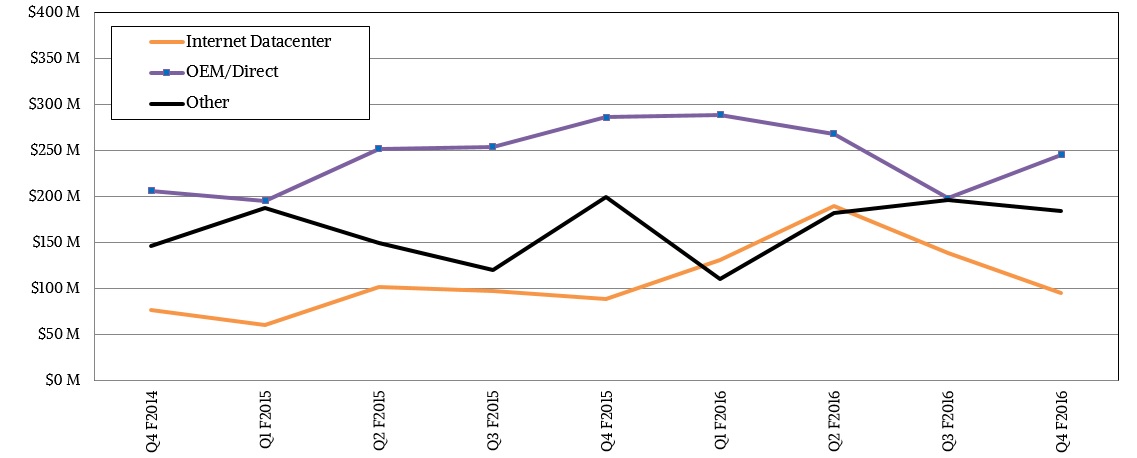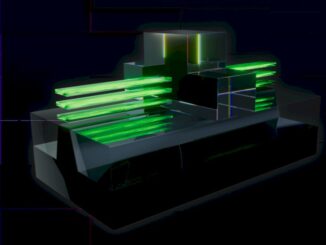
If money were no object and accountants allowed companies to write off investments in systems instantly, then datacenters would be tossing hardware into the scrap heap as soon as new technology came along. But in the real world, companies have to take a more measured approach to adding new systems and upgrading old ones, and that can make the time when customers buy shiny new boxes a bit tough to predict.
Forecasting sales and trying to close them are two of the many challenges that all server, storage, and switching vendors face, and Supermicro, which straddles the line between the tier one OEMs and the world’s largest ODMs, is no different. The company enjoys the boom times, like when a new generation of Intel Xeon processors hits the market when it is most hungry for more performance or some new feature. The “Broadwell” Xeon E5 bump and the rise of hyperscalers has been good for Supermicro, which broker through $2 billion in annual sales for the first time in its history during its fiscal 2016 year, which ended in June.
Supermicro is often at the cutting edge of trends, and so we had a chat with Charles Liang, the company’s founder and CEO, to see what is hot in the upper echelons of the HPC, hyperscale, and cloud markets that the company sells motherboards and whole server and storage systems to. Unfortunately, Liang wants to have a separate conversation about Supermicro’s interest in making Power-based systems, its first foray into a non-X86 systems and, frankly, the first time in the better part of a decade when Supermicro’s product and revenue cycles were not tied so closely to Intel’s product cycles. (The last time was when the company embraced AMD Opteron processors as an alternative to Intel’s Xeons.) As we reported last week, Supermicro is manufacturing two Power8-based systems aimed at volume server buyers on behalf of IBM, and we are dying to know if it will sell these machines directly to end user customers.
In the wake of the Broadwell bump earlier this year, Supermicro’s sales, especially to service providers and cloud builders, cooled a bit. This is a perfectly normal trend, although the ups and downs are more dramatic if a few big customers push out a deal by a quarter or so. (The same thing happens to Hewlett Packard Enterprise, Dell, Lenovo, and others that sell to the big names on the Internet.) With Broadwell Xeon E5 v4 processors preshipping to big customers last fall and launching formally this March, you might be thinking that there is a pause in spending happening now as customers await the “Skylake” Xeon E5 v5 processors and system components that Intel will put into the field sometime next year.
Without revealing precise timing, Liang tells The Next Platform that the Skylake Xeons are still a few quarters away, and that for the next two to three quarters, the majority of systems that Supermicro sells will be based on Broadwell processors. He adds that the Supermicro engineers are hard at work to be first to market with volume shipments of systems employing chips, and that at least among its more than 700 customers (which include service providers, cloud builders, hyperscalers, and other Internet brands as well as a slew of customers who sell systems to others and buy Supermicro components or whole systems to add their value to), “not many people are waiting for Skylake.”
“These transitions always take time,” says Liang, “but usually our customers make the transition earlier than the market at large.” He estimates that somewhere between 40 percent and 50 percent of the currently shipping machines (Supermicro has 65 different SKUs of compute and storage servers) are using Broadwell motors at this point. The majority of the remainder are based on the prior generation of “Haswell” Xeon E5 v3 processors, which made their debut two years ago and which are socket compatible with the Broadwell Xeons, and hence a relatively easy transition for both manufacturers like Supermicro and their customers alike.
“Skylake will be an interesting product, and the architecture is much improved,” Liang tells us. “Memory bandwidth will be more than 50 percent higher, for example. So we think it will be a really strong refresh.”
We detailed some of the feeds and speeds of the Skylake Xeon processors last year, based on then-current roadmaps, but these are always subject to change and have to be taken with a grain of salt. The future Intel “Purley” platform looks like it will do away with the distinction between Xeon E5 and Xeon E7 processors in some fashion, and will also have 512-bit AVX vector math units pulled from the Xeon Phi line, a new NUMA link between sockets called UPI, and a memory architecture called “Adams Pass” that will integrate 3D XPoint memory sticks with DDR4 memory sticks in the same system. The Skylake Xeons will also have variants that have integrated Omni-Path networking ports on either on the chip or in the package.
If customers can wait for Skylake, they will, but only the largest HPC centers and hyperscalers are privy to Intel’s designs and schedules and only they have access to the technology as it comes hot out of the fabs. The rest of us have to rely on whatever data we can piece together and try to plan accordingly. Large enterprises have pretty long cycles to qualify new architectures to support their applications, so the Skylake Xeon could possibly take a little longer to ramp because it is so different. Then again, the appetite for the new features, such as higher memory bandwidth and a broader and deeper memory hierarchy, could be so strong that companies invest heavily. It all comes down to specific software cases and long-term planning. When you need to add 30 percent capacity to a cluster today, you can’t wait three quarters.
Blades Cut To The Chase Scene, Finally
Even without Skylake Xeons being in the field, Liang says that two technologies are driving Supermicro’s compute and storage server businesses higher. The first is, oddly enough, the blade server form factor. Yes, blades have been around since the late 1990s, and yes, the market did not embrace them to the level that many had anticipated. But thanks to steady engineering progress and cutting manufacturing costs, Liang says that Supermicro’s two blade lines – the MicroBlade hyperscale systems and the SuperBlade modular designs – are growing very fast.
Liang puts some numbers on this trend, which runs counter to the conventional wisdom that blades are becoming a thing of the past and that rack servers still reign supreme. In the last five years, depending on the year, the MicroBlade and SuperBlade systems comprised somewhere between 3 percent and 4 percent of shipments, Liang estimates. And as the fiscal 2016 year came to an end in June, blade servers represented about 10 percent of shipments, and Liang thinks that blades could represent 20 percent or maybe even more share of the company’s shipments next fiscal year. The SuperBlade business is doubling every year now, and the MicroBlade business is growing by 3X to 4X, depending on the quarter. So Supermicro is clearly on to something.
The other hot technology right now is NVM-Express peripheral ports for coupling flash-based storage more closely with the compute complex. As we all know, hanging flash off of disk controllers that were not designed for huge numbers of I/O operations does not make a lot of sense, and the wide availability of NVM-Express drives and servers that support them is helping to push this market along. Liang says that about 8 percent of the compute and storage servers that Supermicro is shipping these days support NVM-Express attachment of flash, and he says that within the next three to four months it will hit 20 percent. “It will have to wait for many years to hit 100 percent,” says Liang with a laugh, “but it is my personal believe that NVM-Express attach rates could hit 50 percent within the next three years – and maybe the next two.”
The reason is simple, as we have explained before. The NVM-Express protocol strips out all of the gunk in storage drivers for operating systems and microcode in controllers that makes the PCI-Express bus talk to disk drives. All of that gunk adds a huge amount of latency and overhead to talking to flash, which negates some of its benefit. So by stripping down flash drivers so machines talk more cleanly right to flash drives is a beautiful thing. There are two important benefits. First, tricks used to more tightly link flash to compute can be reused to link 3D XPoint more tightly to processors, and second, even though NVM-Express takes some engineering, which add costs, systems that rely on it are also simpler and this washes that extra cost out, according to Liang. Database, storage, and streaming applications that all benefit from NVM-Express can now get its I/O boost essentially for free now that it is a volume component.
If customers, be they corporate customers or value added resellers, want to buy components to build their own systems rather than buy completed SuperServers from Supermicro, the company is happy to do that, and for the right volumes, it can act effectively as an ODM, much as it has done for IBM’s SoftLayer cloud for years. (There is a reason why Supermicro is interested in building OpenPower machines – IBM is going to be its own biggest customer as it builds out Power-based cloudy infrastructure, and IBM is currently Supermicro’s largest customer and one that does not particularly want to help the X86 cause.)
As you can see from the chart above, though, Supermicro has been concentrating more and more on being a system, rather than a component, supplier. In fact, the revenue positions of these two revenue streams have flipped in the past six fiscal years since the Great Recession started to wane in calendar 2010. In fiscal 2016, systems comprised just under 70 percent of the company’s $2.23 billion in revenues, and Supermicro shipped 358,000 systems in total, up 14.4 percent, with revenues for servers alone rising 26.7 percent to $1.54 billion. Average selling prices of systems have been on the rise over this seven year period and average $4,300 a pop, nearly triple what it was at the beginning of the period covered in our charts.
This is a true feat, considering all of the pressure from the ODMs at the high end and the OEMs in the enterprise, and it is arguably the reason Supermicro has any profits at all in such a cut-throat server market. It all comes down too engineering – the real stuff, not the financial kind that some IT suppliers indulge in just a little too much to appease Wall Street. You know who you are.








Be the first to comment